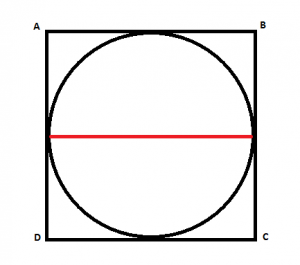
Welcome to “Land Your Score,” a blog series in which Kaplan instructor Jennifer Land shares key insights and strategies for improving your GMAT performance on Test Day. This week, Jennifer continues her discussion of how to solve Data Sufficiency problems using the Kaplan Method.
Today we will continue to deconstruct the following Data Sufficiency (DS) question taken from the GMAT:
What is the area of square ABCD?
(1) The longest line segment that can be drawn through any two points on the perimeter of square ABCD is 4√2.
(2) When a circle is inscribed in square ABCD, the longest line segment connecting two points on the circumference of the circle that can be drawn has a length of 4.
As you’ll recall from my previous post, we determined that Statement (1) is sufficient by evaluating it using the Kaplan Method.
The Kaplan Method for Data Sufficiency
Step 1. Analyze the question stem.
- Determine whether it’s a Value or Yes/No question.
- Simplify.
- Identify what is needed to answer the question.
Step 2. Evaluate the statements using 12TEN.
Using 12TEN to your advantage
As a reminder, Data Sufficiency answer choices never change on the GMAT. Instead of thinking of them by standard multiple choice letter designations, we at Kaplan use a more intuitive method.
1: Statement (1) BY ITSELF is sufficient.
2: Statement (2) BY ITSELF is sufficient.
T: Together Statements (1) and (2) provide sufficiency (but BY ITSELF, neither does).
E: Either statement BY ITSELF is sufficient to answer the question.
N: Neither statement is sufficient, either BY ITSELF or TOGETHER.
Because we determined that Statement (1) is sufficient, we keep 1 as a possible answer choice. And here is where remembering 12TEN comes in super handy: If (1) by itself is sufficient, we will not try them together. Together is not an option if one or both of the statements are sufficient. We also know that N cannot be the answer, because at minimum Statement (1) is sufficient.
What might be hard to spot at first is that we can also eliminate 2 as an answer choice. Because Statement (1) is sufficient, 2 cannot be the answer; if Statement (2) turns out to be sufficient, the answer is Either (E).
So, here we keep 1 and E, but we can eliminate 2, T, and N. Our answer choices look like this:
1
2
TE
N
Now we are ready to look at Statement (2) BY ITSELF.
Drawing the figure
Statement (2) tells us, “When a circle is inscribed in square ABCD, the longest line segment connecting two points on the circumference of the circle that can be drawn has a length of 4.” To understand what this means, we need to draw the figure.
The longest line that can be drawn between two points on a circle is the diameter; I’ve drawn it in red.
Is there sufficient data?
Statement (2) tells us that the diameter of this circle is 4. What line segment is the same length as the diameter of the circle? The side of the square. And because the question stem asks for the area of the square, all we would need is the length of a side of the square to find the value. Therefore, Statement (2) is also sufficient.
It may seem odd to strike (1) from the remaining answer choices, since the statement is sufficient, but that is exactly what we do now. Because EITHER statement BY ITSELF is sufficient to answer the question, E is the correct answer. Click it confidently and move on to the next question!
Stay tuned for my next post, in which we’ll return to Verbal Reasoning to knock Reading Comprehension out of the park!
Want to master Data Sufficiency on the GMAT? Visit Kaptest.com/gmat to explore our course options.
The post Land Your Score: Data Sufficiency Problems, Part 2 appeared first on Business School Insider.

